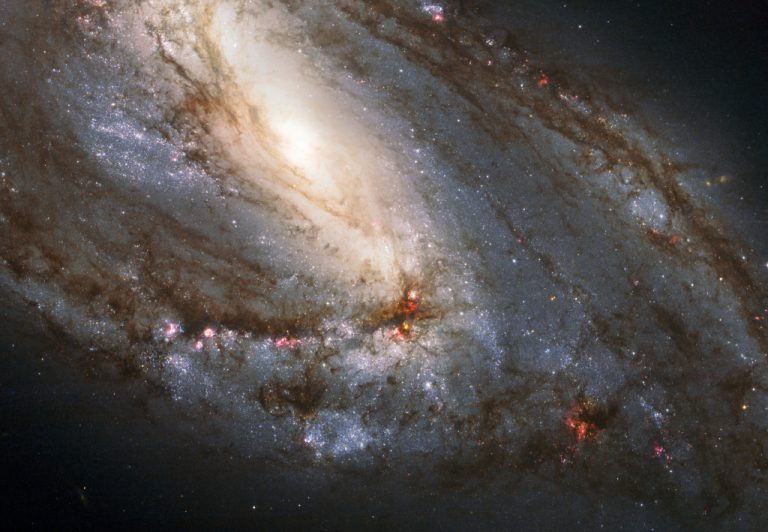Space Photo by NASA Today: 2024 June 13
Discovering Messier 66: A Galactic Marvel
Key Takeaway
Messier 66, also known as NGC 3627, is a breathtaking spiral galaxy located approximately 35 million light-years from Earth. This celestial wonder, part of the Leo Triplet, boasts a size comparable to our Milky Way and features intricate details observable through powerful telescopes like the Hubble Space Telescope.
Space Photo by NASA Today: 2024 June 13
Summary
- Messier 66 (NGC 3627): A spiral galaxy located 35 million light-years from Earth in the constellation Leo.
- Size: Approximately 100,000 light-years across.
- Galactic Core: Likely houses a supermassive black hole.
- Distinctive Features: Includes dust lanes, young star clusters, and star-forming regions.
- Leo Triplet: Part of a trio of interacting galaxies.
- Observation: Detailed views provided by the Hubble Space Telescope.
Messier 66: A Detailed Exploration
Messier 66, also designated as NGC 3627, stands as a prominent member of the Leo Triplet, a gravitationally interacting group of galaxies. Located in the constellation Leo, Messier 66 is an impressive spiral galaxy that captures the fascination of astronomers and space enthusiasts alike. Spanning about 100,000 light-years in diameter, it shares a similar size with our own Milky Way galaxy.
The galaxy was discovered by the renowned French astronomer Charles Messier on March 1, 1780. Messier was compiling a list of “nebulae” and “star clusters” to help comet hunters avoid mistaking these fixed objects for comets. Thus, Messier 66 earned its place as the 66th entry in his famous catalog.
Structure and Composition
At the heart of Messier 66 lies its bright core, which is thought to harbor a supermassive black hole. This core is surrounded by spinning dust lanes and young, blue star clusters, adding to the galaxy’s dynamic and vibrant appearance.
The galaxy’s disk is notably inclined to our line of sight, giving us a distinctive view of its spiral structure. The spiral arms are dotted with pinkish regions that indicate active star formation. These regions glow due to the presence of ionized hydrogen gas illuminated by young, hot stars.
Observational Highlights
The Hubble Space Telescope has provided some of the most detailed images of Messier 66, highlighting its intricate structure. The close-up views reveal the complex interplay of dust, gas, and stars within the galaxy, allowing astronomers to study its composition and behavior in great detail.
Key Features
- Dust Lanes: Dark, obscuring paths that weave through the galaxy, highlighting areas where star formation may be inhibited by dense clouds of gas and dust.
- Star Clusters: Groups of young, blue stars that are bright and hot, indicating recent star formation.
- Star-Forming Regions: Pinkish areas scattered along the spiral arms, where new stars are being born.
Interaction within the Leo Triplet
Messier 66 is part of the Leo Triplet, along with Messier 65 and NGC 3628. These galaxies are gravitationally interacting, which influences their shapes and star formation activities. Such interactions can trigger waves of star formation as gas clouds are compressed.
The Leo Triplet offers a unique opportunity to study galaxy interactions and their effects. By observing these galaxies, astronomers can gain insights into the processes that govern galaxy evolution and the role of gravitational forces in shaping their structures.
Scientific Discoveries and Theories
Research on Messier 66 has provided valuable data on star formation processes. The galaxy’s active regions serve as natural laboratories for understanding how stars form and evolve. Additionally, the dynamics of its spiral arms offer clues about the internal and external forces acting upon the galaxy.
Black Hole Studies
The presence of a supermassive black hole at the galaxy’s core has been a subject of intense study. Observations suggest that the black hole’s mass and the rate of material falling into it can significantly affect the galaxy’s core dynamics and energy output.
Comparative Analysis
| Characteristic | Milky Way | Messier 66 |
|---|---|---|
| Diameter | ~100,000 light-years | ~100,000 light-years |
| Distance from Earth | N/A | 35 million light-years |
| Number of Stars | 100-400 billion | Estimated similar |
| Star Formation Rate | 1-2 stars per year | Higher due to interactions |
| Central Black Hole Mass | 4 million solar masses | Estimated similar |
Astronomical Tools and Techniques
Advanced telescopes like the Hubble Space Telescope and ground-based observatories equipped with adaptive optics have been crucial in capturing high-resolution images of Messier 66. These tools allow astronomers to observe the galaxy in various wavelengths, from visible light to infrared and radio waves.
Spectroscopy
Spectroscopic analysis helps determine the composition, temperature, density, and motion of the gas and stars within Messier 66. This technique provides insights into the physical conditions and processes occurring in different parts of the galaxy.
Notable Observations and Research
Hubble’s observations have been pivotal in enhancing our understanding of Messier 66. The detailed images reveal the complexity of the galaxy’s structure and the interactions within the Leo Triplet.
Future Missions and Prospects
Upcoming space telescopes, such as the James Webb Space Telescope, are expected to provide even more detailed observations of galaxies like Messier 66. These future missions will delve deeper into the study of star formation, galactic dynamics, and the properties of supermassive black holes.
Messier 66 is a captivating example of the beauty and complexity of spiral galaxies. Its dynamic structure, star-forming regions, and interaction with neighboring galaxies offer a wealth of information for astronomers. As we continue to explore the universe, Messier 66 serves as a testament to the wonders that lie beyond our own galaxy.
References
- Messier, C. (1781). Catalogue of Nebulae and Star Clusters.
- NASA/ESA Hubble Space Telescope. (2024). Hubble Heritage Project.
- De Martin, D., & Gendler, R. Image Acknowledgment for Messier 66.
- Wiseman, J. (2024). Hubble Space Telescope Observations.

